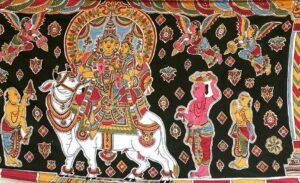If you live in India, you could not have missed hearing the word ‘kalamkari.’ Chances are, you own something made of kalamkari fabric—a piece of clothing, perhaps, or a home décor item.
Kalamkari is an ancient art—from “kalam” i.e. pen, and “qari”, i.e. craftsmanship. We even know this.
However, there is much more to Kalamkari than just these facts. The art form has a rich history that spans centuries, a lot of it very interesting!
For instance, did you know that the craft, in its own way, threatened the economy of three European countries? Read on to know more.
1. You might know of two types of kalamkari, both in Andhra: the Machilipatnam style and the Srikalahasti style. There is, however, a third style that even has a GI tag. It’s the Karuppur Kalamkari style of Tamil Nadu that is now primarily used to adorn temple chariots and doorways.

Karuppur Kalamkari @TheIndianSareeJournal
2. The Srikalahasti style is still mostly hand painted, but the Machilipatnam style has moved to block printing of designs. This may have to do with the fact that Machilipatnam is a port town and was known to be the export point for Kalamkari textiles.
3. The Srikalahasti style features a lot of Hindu iconography, while the Machilipatnam style, patronized by the Golconda rulers, features more themes from nature: leaves, flowers, and the like.

European ‘chintz’, inspired by Kalamkari.
4. Kalamkari and its derivative, “Chintz,” were the reasons for a law to outlaw imports of cotton to England. A kalamkari-inspired cloth, called chintz (meaning ‘spotted’), was exported to England and France by the East India Company, creating huge losses for English millowners. This was a major issue in the 1680s to 1740s in Europe. Imported cotton was eventually banned in England, France, and Spain. This led to the mechanization of mills, contributing largely to the Industrial Revolution.
5. While the craft of kalamkari is still practised today, it’s not as widespread as it used to be. The actual process of making Kalamkari involves 23 steps; there are 17 steps involved in the printing process alone! This laborious technique means that only a few select artisans are willing and able to perform this task as it was done in the past.
6. The Buddha motif has become very popular in recent years. While there are references to kalamkari in ancient Buddhist texts, this recent design of the Kalamkari Buddha may have to do with demands of the market.
7. The United States, Italy and Nepal are the leading importers of Kalamkari products from India, with the United States having the lion’s share at around 85%.
It’s mind boggling to think that every single art form has a history that spans generations, moulding it to its current state. It is our responsibility to know more and patronize our Indian art forms whenever possible.
Check out our website for these kalamkari-inspired products!

